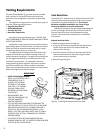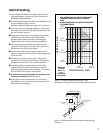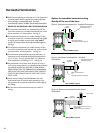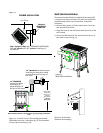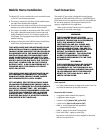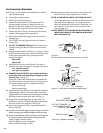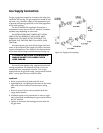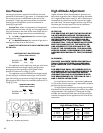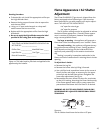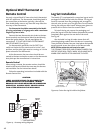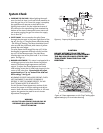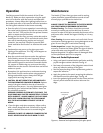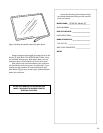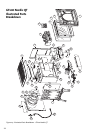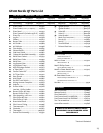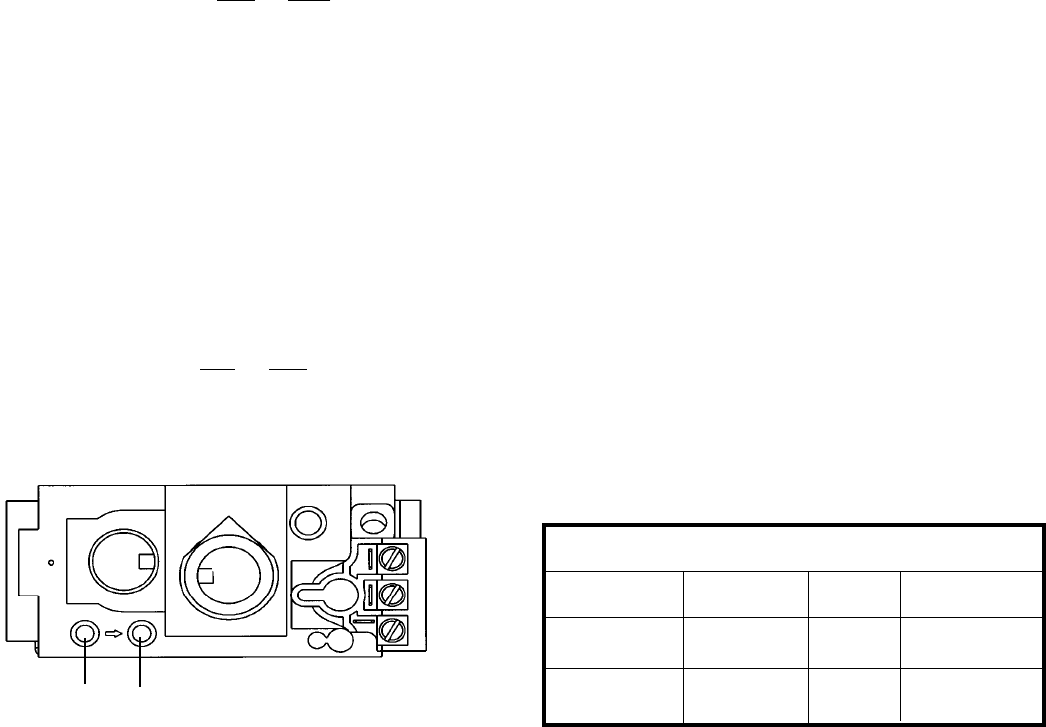
16
Gas Pressure
Correct gas pressure is essential for efficient and safe
operation of the Nordic QT gas stove. It is important that
the correct pressure is established at the time of the
installation. Proper gas pressure provides a consistent
flow of gas to the appliance and is instrumental in
checking for gas leaks.
Pressure Test: Attach a manometer to the appropri-
ate test point on the valve. See fig. 20. The gauge connec-
tions are located on the front of the valve under the On/
Off/Pilot- knob. Gauge connections are identified by:
E - for Inlet or Supply Pressure (the amount of gas
coming to the valve.)
A - for Manifold Pressure (the amount of gas that is
coming out of the valve to the burner.)
ALWAYS TEST PRESSURES WITH VALVE CONTROL KNOB
SET ON HIGH.
High Altitude Adjustment
Higher altitudes affect the atmospheric pressure and
heat value of gaseous fuels. When installing the Nordic
QT in high altitude (above 2500'), it will be necessary to
compensate for the thinner air (less volume of oxygen
per cubic foot). The lower oxygen content in the air and
the lower gas viscosity require the use of a different
orifice to achieve efficient combustion.
IN THE U.S:
THE DERATING KIT MUST BE INSTALLED BY
AN AUTHORIZED SERVICE TECHNICIAN IN
ACCORDANCE WITH THE MANUFACTURER’S
INSTRUCTIONS AND ALL CODES AND RE-
QUIREMENTS OF THE AUTHORITY HAVING
JURISDICTION. THE INFORMATION STICKER
MUST BE FILLED OUT BY THE INSTALLER
AND ADHERED TO THE APPLIANCE AT THE
TIME OF THE CONVERSION. THE QUALIFIED
SERVICE AGENCY PERFORMING THIS WORK
ASSUMES RESPONSIBILITY FOR THIS DERAT-
ING.
IN CANADA,
THIS UNIT HAS BEEN TESTED FOR INSTALLA-
TION AT HIGH ALTITUDES IN ACCORDANCE
WITH CANADIAN TEST STANDARD CAN/CGA-
2.17.
THE DERATING SHALL BE CARRIED OUT IN
ACCORDANCE WITH THE REQUIREMENTS OF
THE PROVINCIAL AUTHORITIES HAVING
JURISDICTION AND IN ACCORDANCE WITH
THE REQUIREMENTS OF THE CAN1-B-149.1
AND .2 INSTALLATION CODE.
For installations from 610 - 370 meters (2000-4500
ft.) The orifice size for natural gas is #49 and for propane
gas #60. See the chart below
For high altitude installations, consult your local gas
distributor or the authority having jurisdiction for proper
rating methods. If the appliance is converted for high
altitude, the Conversion Label must be filled out by the
installer and applied to the appliance at the time of the
conversion.
NECESSARY INLET GAS PRESSURES
(inches water column)
MIN MAX
NATURAL GAS 5.0 7.0
PROPANE 11.0 13.5
The appliance and its appliance main gas valve must
be disconnected from the gas supply piping system
during any pressure testing on that system at test
pressures in excess of 1/2 psig (3.5 kPa).
The appliance must be isolated from the gas supply
line by closing its individual manual gas shut-off valve
(gas cock) during any pressure testing of the gas supply
piping system that is equal to or exceeds pressures of 1/
2 psig (3.5 kPa).
MANIFOLD PRESSURES
(inches water column)
MIN MAX
NATURAL GAS 2.2 3.5
PROPANE 6.5 10.0
E
A
Figure 20. Pressure test points.
High Altitude Orifice Chart
Elevation Fuel Part No.
0 - 2000 ft. Natural Gas #49 129411
(0 - 610 m) Propane #59 129482
2001 - 4500 ft. Natural Gas #49 Do Not Derate
(611 - 1370 m) Propane #60 54387
Orifice
Size



